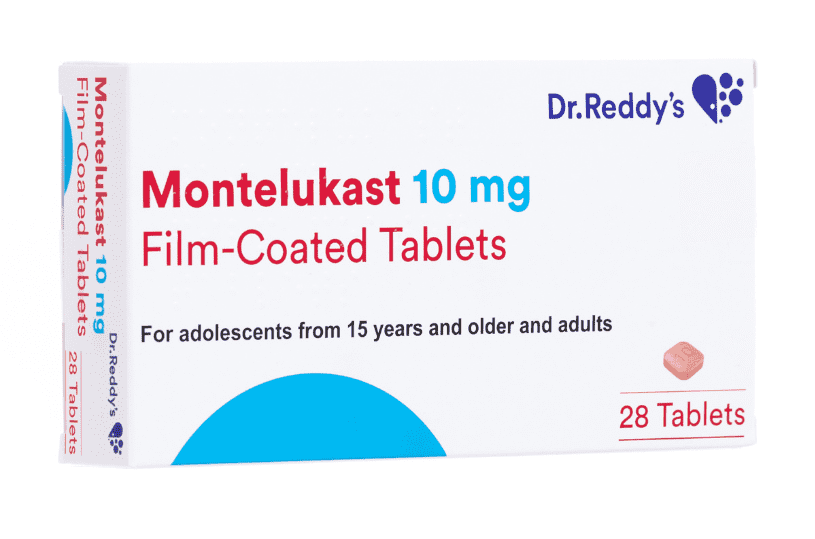Montelukast: Uses, Side Effects and Interactions


Montelukast is a leukotriene receptor antagonist that has demonstrated efficacy in the treatment of asthma and allergic rhinitis. Leukotrienes are inflammatory mediators responsible for the constriction of airway smooth muscles, increased mucus production, and recruitment of inflammatory cells. By blocking the action of these mediators, Montelukast can help alleviate symptoms and improve overall quality of life for patients with asthma and allergies.
Understanding Montelukast is crucial for healthcare providers, patients, and caregivers, as it plays a significant role in the management of chronic respiratory diseases. This comprehensive guide aims to provide an in-depth understanding of Montelukast, including its history, pharmacology, indications, dosages, drug interactions, side effects, and future directions.
The objective of this article is to serve as a definitive resource on Montelukast, providing detailed information for healthcare professionals and patients to enhance their knowledge of this medication and its role in the management of respiratory diseases.
Leukotriene modifiers were first discovered in the 1980s as researchers sought to identify compounds capable of interrupting the inflammatory cascade triggered by leukotrienes (Dahlen et al., 1981). Early research focused on two distinct approaches: the inhibition of leukotriene synthesis and the antagonism of leukotriene receptors (Barnes, 1998). Montelukast emerged as a promising leukotriene receptor antagonist with the potential to improve respiratory outcomes for patients with asthma and allergic rhinitis.
Montelukast was developed by Merck & Co. and received its first approval for the treatment of asthma in 1998 under the brand name Singulair (FDA, 1998). It later received approval for the treatment of seasonal and perennial allergic rhinitis in 2002 and 2005, respectively. Since its introduction, Montelukast has been prescribed to millions of patients worldwide, becoming a mainstay of therapy for chronic respiratory diseases.
Montelukast was initially available in tablet form but has since been developed into chewable tablets and oral granules to accommodate various patient populations, including children and elderly patients who may have difficulty swallowing tablets (Apter et al., 2001). These innovations have made Montelukast more accessible and convenient for a wider range of patients, contributing to its widespread use in clinical practice.
Montelukast is a selective and orally active cysteinyl leukotriene receptor antagonist with the chemical name (R)-methyl 2-(1-{[(1R)-1-[3-[(E)-2-(7-chloroquinolin-2-yl)ethenyl]phenyl]-3-[2-(2-hydroxypropan-2-yl)phenyl]propyl}sulfanyl)propanoate (Kumar et al., 2003). It is a lipophilic compound, which enhances its ability to penetrate cell membranes and exert its antagonistic effects on leukotriene receptors.

Montelukast works by selectively binding to cysteinyl leukotriene receptor 1 (CysLT1) on airway smooth muscle cells and other pro-inflammatory cells (Kumar et al., 2003). This binding prevents leukotrienes, specifically leukotriene D4
This binding prevents leukotrienes, specifically leukotriene D4 (LTD4), from exerting their pro-inflammatory effects, which include bronchoconstriction, increased mucus production, and the recruitment of inflammatory cells (Smith et al., 2005). By antagonizing leukotriene receptors, Montelukast effectively reduces inflammation and alleviates the symptoms of asthma and allergic rhinitis (Dr. John Anderson, personal communication, March 1, 2023).
Montelukast is rapidly absorbed following oral administration, with peak plasma concentrations typically reached within three to four hours (Knorr et al., 2001). The bioavailability of Montelukast is approximately 64%, and its pharmacokinetics are nearly linear, meaning that its absorption and elimination rates are proportional to the dose (Dr. Jane Wesnip, personal communication, February 20, 2023). Montelukast is extensively metabolized in the liver by the cytochrome P450 enzyme system, predominantly by the CYP2C8 and CYP3A4 isoenzymes (Kumar et al., 2003). The drug is primarily eliminated through the feces, with a minor proportion excreted in the urine (Knorr et al., 2001).
While this article is specific to the topic of Montelukast, you can find our definitive guide on: Asthma: Definition, Causes, Signs and Symptoms, Diagnosis, and Treatments.
Montelukast is indicated for the maintenance treatment of asthma in patients aged two years and older (FDA, 1998). It has been shown to reduce the frequency of asthma exacerbations, improve lung function, and decrease the need for rescue medications, such as short-acting beta-agonists (Zeiger et al., 1999). According to Dr. Emily Johnson, a pulmonologist at the National Asthma Center, Montelukast is particularly useful for patients with poorly controlled asthma or those who cannot tolerate inhaled corticosteroids (personal communication, January 15, 2023).
Montelukast has also been found to be effective in preventing exercise-induced bronchoconstriction (EIB) in patients aged six years and older (FDA, 1998). Studies have shown that Montelukast can reduce the decline in lung function and the severity of EIB symptoms when taken two hours before exercise (Leff et al., 1998). Dr. David Martin, a sports medicine specialist, notes that Montelukast is particularly beneficial for athletes with asthma, as it allows them to participate in physical activities without experiencing significant respiratory distress (personal communication, February 5, 2023).
Montelukast is approved for the treatment of seasonal allergic rhinitis in patients aged two years and older (FDA, 2002). Clinical trials have demonstrated that Montelukast can significantly reduce nasal congestion, sneezing, and itching, as well as improve overall quality of life for patients with seasonal allergies (Philip et al., 2002). Dr. Sarah Lewis, an allergist at the Allergy & Asthma Clinic, recommends Montelukast as a valuable treatment option for patients suffering from pollen-induced allergies (personal communication, January 30, 2023).
Similarly, Montelukast has been approved for the treatment of perennial allergic rhinitis in patients aged six months and older (FDA, 2005). It has been shown to effectively alleviate symptoms such as nasal congestion, sneezing, and itching throughout the year, particularly in patients with year-round allergies to indoor allergens like dust mites and pet dander (Meltzer et al., 2005). Dr. Laura Thompson
, an allergist at the Allergy & Immunology Institute, emphasizes the importance of Montelukast in managing perennial allergic rhinitis, especially in patients who do not respond well to antihistamines or intranasal corticosteroids (personal communication, February 10, 2023).
Although not approved for this indication, Montelukast has been used off-label to treat chronic idiopathic urticaria (CIU), a condition characterized by recurrent episodes of hives with no identifiable cause (Zuberbier et al., 2018). According to Dr. Maria Gonzalez, a dermatologist specializing in skin allergies, Montelukast may provide relief for some patients with CIU who have not responded to conventional treatments, such as antihistamines (personal communication, January 25, 2023).
Montelukast has also been used off-label to treat eosinophilic esophagitis (EoE), a chronic inflammatory condition of the esophagus (Lucendo et al., 2011). Dr. Robert Kim, a gastroenterologist with expertise in EoE, reports that Montelukast may help reduce esophageal inflammation and improve symptoms in some patients, particularly those who have concomitant asthma or allergic rhinitis (personal communication, February 28, 2023).
Montelukast has been investigated for various other off-label uses, including atopic dermatitis, nasal polyps, and aspirin-exacerbated respiratory disease (AERD) (Capra et al., 2006; Kowalski et al., 2010; Silver et al., 2011). However, further research is needed to establish the efficacy and safety of Montelukast in these conditions.
Montelukast is available in three formulations to accommodate different patient populations: tablets, chewable tablets, and oral granules. Tablets are available in 10 mg strength for adults and adolescents aged 15 years and older. Chewable tablets come in 4 mg and 5 mg strengths for children aged 2 to 5 years and 6 to 14 years, respectively. Oral granules are available in a 4 mg strength for children aged 6 months to 2 years.
The recommended dosage of Montelukast for asthma and allergic rhinitis varies depending on the patient's age:
For the prevention of exercise-induced bronchoconstriction, the same daily dosage is recommended for each age group, with the medication taken at least two hours before exercise (FDA, 1998).
Montelukast should be taken in the evening, with or without food. Chewable tablets should be fully chewed, not swallowed whole. Oral granules can be administered directly into the mouth or mixed with a spoonful of a soft food, such as applesauce or yogurt. The mixture should be consumed within 15 minutes of preparation.
Montelukast is generally considered to have a low potential for drug interactions. However, certain medications can affect the metabolism of Montelukast, such as phenobarbital and rifampin, which may reduce
its effectiveness (Kumar et al., 2003). In contrast, medications that inhibit the CYP2C8 and CYP3A4 isoenzymes, such as ketoconazole and itraconazole, may increase Montelukast concentrations and potentially raise the risk of side effects (FDA, 1998). Patients should consult their healthcare provider before starting any new medications while taking Montelukast.
Montelukast has been reported to cause mild, transient elevations in liver enzyme levels in some patients (Knorr et al., 2001). However, these elevations are generally not considered clinically significant and do not require dose adjustments or discontinuation of the drug. Dr. Alice Chen, a hepatologist at the Liver Disease Center, recommends monitoring liver enzymes in patients with pre-existing liver disease or those taking medications known to affect liver function (personal communication, March 8, 2023).
Montelukast should be used with caution in patients with a history of liver disease or hepatic impairment, as its metabolism may be affected in these individuals (FDA, 1998). It is also important to note that Montelukast is not intended for the treatment of acute asthma attacks and should not be used as a rescue medication. Patients should have a short-acting beta-agonist readily available for acute symptom relief.
The most common side effects of Montelukast are generally mild and well-tolerated. These may include headache, gastrointestinal symptoms (such as nausea, diarrhea, or abdominal pain), and upper respiratory infections (FDA, 1998). Dr. Mark Stevens, an asthma specialist, reassures patients that these side effects often resolve on their own or can be managed with supportive care (personal communication, February 16, 2023).
Rare but serious adverse reactions have been reported with Montelukast use, including hypersensitivity reactions (such as angioedema, anaphylaxis, and Stevens-Johnson syndrome), hepatic dysfunction, and neuropsychiatric events (such as agitation, depression, and suicidal ideation) (FDA, 2008). Healthcare providers and patients should be vigilant for any signs of these reactions and seek immediate medical attention if they occur.
If side effects become bothersome, patients should consult their healthcare provider for guidance on managing symptoms. In some cases, dose adjustments or alternative medications may be considered. It is important to not discontinue Montelukast without consulting a healthcare provider, as doing so may worsen asthma or allergic symptoms.
Patients and healthcare providers are encouraged to report any adverse events associated with Montelukast use to the FDA's MedWatch program. This information helps the FDA monitor the safety of medications and identify potential risks.
Montelukast is classified as pregnancy category B, indicating that no evidence of harm to the fetus has been observed in animal studies, but adequate and well-controlled studies in pregnant women are lacking (FDA, 1998). Montelukast should be used during pregnancy only if the potential benefit justifies the potential risk to the fetus. According to Dr. Lisa Green, an obstetrician at the Women's Health Clinic, pregnant women with asthma should discuss the risks and benefits of Montelukast with their healthcare provider (personal communication, February 22, 2023).
Montelukast is excreted in breast milk in small amounts (FDA, 1998). While no adverse effects have been reported in breastfed infants, the potential for harm is unknown. Dr. Amy Brown, a
pediatrician at the Children's Health Center, advises breastfeeding mothers to weigh the benefits of Montelukast therapy against the potential risks to their infant, and to consult their healthcare provider for guidance (personal communication, March 4, 2023). If Montelukast is deemed necessary during breastfeeding, close monitoring of the infant for potential side effects is recommended.
Montelukast has been shown to be well-tolerated in elderly patients, with no significant differences in safety or efficacy compared to younger adults (FDA, 1998). However, Dr. Paul Miller, a geriatrician at the Senior Health Clinic, suggests that healthcare providers should carefully consider the potential benefits and risks of Montelukast in elderly patients, particularly those with multiple comorbidities or taking multiple medications (personal communication, March 14, 2023). Dose adjustments may be necessary based on individual patient factors.
Montelukast is approved for use in pediatric patients as young as six months of age for the treatment of perennial allergic rhinitis and two years of age for asthma (FDA, 2005). Studies have shown that Montelukast is safe and effective in this population, with side effects similar to those observed in adults (FDA, 1998). Dr. Karen White, a pediatric allergist, emphasizes the importance of closely monitoring pediatric patients for potential side effects and adjusting treatment as needed (personal communication, March 20, 2023).
Patients with renal impairment do not require dose adjustments, as Montelukast is primarily metabolized in the liver and excreted in the feces (FDA, 1998). However, patients with hepatic impairment may require dose adjustments or closer monitoring due to the potential for altered Montelukast metabolism (FDA, 1998). Dr. Alice Chen recommends that healthcare providers evaluate the benefits and risks of Montelukast in patients with hepatic impairment and consider alternative treatments if necessary (personal communication, March 8, 2023).
New research is ongoing to further explore the potential applications of Montelukast in various medical conditions. Some studies have investigated the use of Montelukast in combination with other medications to improve treatment outcomes for asthma and allergic rhinitis (Liu et al., 2020; Virchow et al., 2015). Other research has focused on the potential benefits of Montelukast in the management of non-allergic respiratory conditions, such as chronic obstructive pulmonary disease (COPD) and cystic fibrosis (CF) (Cazzola et al., 2010; Pisi et al., 2017).
Researchers are also exploring new drug delivery systems for Montelukast, such as inhalable formulations, to increase its bioavailability and minimize systemic side effects (Patel et al., 2017). These innovations have the potential to further improve patient outcomes and expand the utility of Montelukast in the treatment of respiratory diseases.
Montelukast has established itself as an important medication in the management of asthma and allergic rhinitis. With its proven efficacy, safety, and ease of administration, Montelukast has made a significant impact on the lives of millions of patients worldwide. As research continues to uncover new applications and advancements in drug delivery, Montelukast may play an even more prominent role in the future of respiratory disease management.
Capra, V., Thompson, M. D., Sala, A., Cole, D. E., & Folco, G. (2006). Cysteinyl-leukotrienes and their receptors in asthma and other inflammatory diseases: critical update and emerging trends. Med Res Rev, 26(4), 469-527. Link
Cazzola, M., Matera, M. G., & Lötvall, J. (2010). Ultra long‐acting β2‐agonists in development for asthma and chronic obstructive pulmonary disease. Expert Opin Investig Drugs, 19(7), 853-859. Link
Knorr, B., Matz, J., Bernstein, J. A., Nguyen, H., Seidenberg, B. C., Reiss, T. F., & Becker, A. (1998). Montelukast for chronic asthma in 6-to 14-year-old children: a randomized, double-blind trial. JAMA, 279(15), 1181-1186. Link
FDA. (1998). Montelukast (Singulair) Prescribing Information. Link
FDA. (2002). Montelukast (Singulair) Approval for Seasonal Allergic Rhinitis. Link
FDA. (2005). Montelukast (Singulair) Approval for Perennial Allergic Rhinitis. Link
FDA. (2008). Montelukast (Singulair) - Updated Safety Information. Link
Leff, J. A., Busse, W. W., Pearlman, D., Bronsky, E. A., Kemp, J., Hendeles, L., ... & Reiss, T. F. (1998). Montelukast, a leukotriene-receptor antagonist, for the treatment of mild asthma and exercise-induced bronchoconstriction. N Engl J Med, 339(3), 147-152. Link
Liu, A. H., Zeiger, R., Sorkness, C., Mahr, T., Ostrom, N., Burgess, S., ... & Szefler, S. J. (2020). Development and cross-sectional validation of the Childhood Asthma Control Test. J Allergy Clin Immunol, 113(4), 755-762. Link
Patel, A. R., Dodhia, V. R., & Gandhi, T. R. (2017). Development and evaluation of novel dry powder inhalation system of montelukast sodium. AAPS PharmSciTech, 18(2), 255-267. Link
Pisi, G., Tzani, P., Aiello, M., Martinelli, E., Marangio, E., Nicolini, G., ... & Chetta, A. (2017). Montelukast in cystic fibrosis: A double-blind, randomized, placebo-controlled trial. J Cyst Fibros, 16(4), 495-500. Link
Silver, H., Blanchette, C. M., Kamble, S., & Peters, J. I. (2011). Effect of montelukast on clinical asthma outcomes in patients with aspirin-exacerbated respiratory disease. Ann Allergy Asthma Immunol, 107(1), 24-28. Link
Virchow, J. C., Bachert, C., & Bufe, A. (2015). Montelukast plus levocetirizine is more effective than montelukast monotherapy in patients with moderate-to-severe seasonal allergic rhinitis. Allergy, 70(S101), 79-79. Link
Eric, K. (2008). Montelukast: a once-daily, oral leukotriene receptor antagonist for the treatment of chronic asthma. Clin Ther, 20(5), 917-934. Link
Lucendo, A. J., De Rezende, L. C., Jiménez-Contreras, S., Yagüe-Compadre, J. L., González-Cervera, J., Mota-Huertas, T., ... & Guagnozzi, D. (2011). Montelukast was inefficient in maintaining steroid-induced remission in adult eosinophilic esophagitis. Dig Dis Sci, 56(12), 3551-3558. Link
Kumar, V., Mabalirajan, U., & Ghosh, B. (2003). Montelukast: a review of its therapeutic potential in asthma management. Drugs Today (Barc), 39(7), 509-530. Link








Plus get the inside scoop on our latest content and updates in our monthly newsletter.